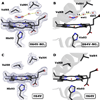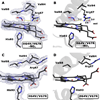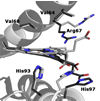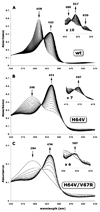The distal pocket histidine residue in horse heart myoglobin directs the O-binding mode of nitrite to the heme iron
- PMID: 19924902
- PMCID: PMC2824769
- DOI: 10.1021/ja904726q
The distal pocket histidine residue in horse heart myoglobin directs the O-binding mode of nitrite to the heme iron
Abstract
It is now well-established that mammalian heme proteins are reactive with various nitrogen oxide species and that these reactions may play significant roles in mammalian physiology. For example, the ferrous heme protein myoglobin (Mb) has been shown to reduce nitrite (NO(2)(-)) to nitric oxide (NO) under hypoxic conditions. We demonstrate here that the distal pocket histidine residue (His64) of horse heart metMb(III) (i.e., ferric Mb(III)) has marked effects on the mode of nitrite ion coordination to the iron center. X-ray crystal structures were determined for the mutant proteins metMb(III) H64V (2.0 A resolution) and its nitrite ion adduct metMb(III) H64V-nitrite (1.95 A resolution), and metMb(III) H64V/V67R (1.9 A resolution) and its nitrite ion adduct metMb(III) H64V/V67R-nitrite (2.0 A resolution). These are compared to the known structures of wild-type (wt) hh metMb(III) and its nitrite ion adduct hh metMb(III)-nitrite, which binds NO(2)(-) via an O-atom in a trans-FeONO configuration. Unlike wt metMb(III), no axial H(2)O is evident in either of the metMb(III) mutant structures. In the ferric H64V-nitrite structure, replacement of the distal His residue with Val alters the binding mode of nitrite from the nitrito (O-binding) form in the wild-type protein to a weakly bound nitro (N-binding) form. Reintroducing a H-bonding residue in the H64V/V67R double mutant restores the O-binding mode of nitrite. We have also examined the effects of these mutations on reactivities of the metMb(III)s with cysteine as a reducing agent and of the (ferrous) Mb(II)s with nitrite ion under anaerobic conditions. The Mb(II)s were generated by reduction of the Mb(III) precursors in a second-order reaction with cysteine, the rate constants for this step following the order H64V/V67R > H64V >> wt. The rate constants for the oxidation of the Mb(II)s by nitrite (giving NO as the other product) follow the order wt > H64V/V67R >> H64V and suggest a significant role of the distal pocket H-bonding residue in nitrite reduction.
Figures









Similar articles
-
Nitrite reduction by Co(II) and Mn(II) substituted myoglobins: towards understanding necessary components of Mb nitrite reductase activity.J Inorg Biochem. 2012 Feb;107(1):47-53. doi: 10.1016/j.jinorgbio.2011.10.006. Epub 2011 Oct 25. J Inorg Biochem. 2012. PMID: 22178665
-
Influence of the heme distal pocket on nitrite binding orientation and reactivity in Sperm Whale myoglobin.Biochem J. 2021 Feb 26;478(4):927-942. doi: 10.1042/BCJ20200596. Biochem J. 2021. PMID: 33543749 Free PMC article.
-
Crystal structures of the nitrite and nitric oxide complexes of horse heart myoglobin.J Inorg Biochem. 2006 Aug;100(8):1413-25. doi: 10.1016/j.jinorgbio.2006.04.011. Epub 2006 May 5. J Inorg Biochem. 2006. PMID: 16777231
-
Nitrite binding to myoglobin and hemoglobin: Reactivity and structural aspects.J Inorg Biochem. 2025 Apr;265:112829. doi: 10.1016/j.jinorgbio.2025.112829. Epub 2025 Jan 11. J Inorg Biochem. 2025. PMID: 39854981 Review.
-
Mechanisms of nitric oxide reactions with globins using mammalian myoglobin as a model system.J Inorg Biochem. 2022 Aug;233:111839. doi: 10.1016/j.jinorgbio.2022.111839. Epub 2022 Apr 22. J Inorg Biochem. 2022. PMID: 35599166 Review.
Cited by
-
Generating S-nitrosothiols from hemoglobin: mechanisms, conformational dependence, and physiological relevance.J Biol Chem. 2013 Aug 2;288(31):22408-25. doi: 10.1074/jbc.M113.482679. Epub 2013 Jun 17. J Biol Chem. 2013. PMID: 23775069 Free PMC article.
-
Synthetic heme/copper assemblies: toward an understanding of cytochrome c oxidase interactions with dioxygen and nitrogen oxides.Acc Chem Res. 2015 Aug 18;48(8):2462-74. doi: 10.1021/acs.accounts.5b00265. Epub 2015 Aug 5. Acc Chem Res. 2015. PMID: 26244814 Free PMC article.
-
Nitric oxide generation from heme/copper assembly mediated nitrite reductase activity.J Biol Inorg Chem. 2014 Jun;19(4-5):515-28. doi: 10.1007/s00775-013-1081-6. Epub 2014 Jan 16. J Biol Inorg Chem. 2014. PMID: 24430198 Free PMC article.
-
Interactions of metronidazole and chloramphenicol with myoglobin: Crystal structure of a Mb-acetamide product.J Porphyr Phthalocyanines. 2023 Jul-Oct;27(7-10):1142-1147. doi: 10.1142/s1088424623500700. J Porphyr Phthalocyanines. 2023. PMID: 37868702 Free PMC article.
-
Substrate binding and activation in the active site of cytochrome c nitrite reductase: a density functional study.J Biol Inorg Chem. 2011 Mar;16(3):417-30. doi: 10.1007/s00775-010-0739-6. Epub 2010 Dec 2. J Biol Inorg Chem. 2011. PMID: 21125303
References
-
- Braida W, Ong SK. Water, Air, and Soil Pollution. 2000;118:13–26.
-
- Averill BA. Chem. Rev. 1996;96:2951–2964. - PubMed
-
- Eady RR, Hasnain SS. Denitrification. In: Que L Jr, Tolman WB, editors. Comprehensive Coordination Chemistry II. Vol. 8. San Diego, CA: Elsevier; 2004. pp. 759–786.
-
- Wasser IM, de Vries S, Moenne-Loccoz P, Schroder I, Karlin KD. Chem. Rev. 2002;102:1201–1234. - PubMed
-
- Tavares P, Pereira AS, Moura JJG. J. Inorg. Biochem. 2006;100:2087–2100. - PubMed
Publication types
MeSH terms
Substances
Grants and funding
LinkOut - more resources
Full Text Sources
Medical
Miscellaneous

